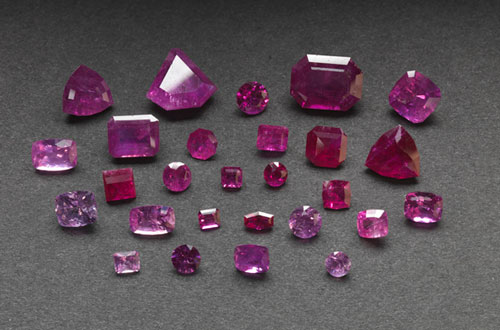What are Corundum Gemstones, and How are they Classified in the World of Gemology?
Corundum gemstones have captivated the human imagination for centuries with their stunning brilliance and vibrant colors. Among them, synthetic sapphire stands out as a remarkable creation of science and technology. In this article, we will delve deep into the world of corundum gemstones, exploring their origins, characteristics, and how they are classified in the realm of gemology. Specifically, we'll shed light on the fascinating realm of synthetic sapphire and its significance in the jewelry industry.
1. The Allure of Corundum Gemstones
The Birth of Corundum
Corundum, a crystalline form of aluminum oxide (Al2O3), is a mineral that occurs naturally in a variety of colors, each with its unique charm. The word "corundum" is derived from the Tamil word "kurundam," which means "ruby" or "sapphire." Corundum's rich history dates back to ancient times when these gemstones were cherished for their beauty and believed to possess mystical properties.

Natural Varieties of Corundum
Corundum exists in several color varieties, with the most famous being:
Ruby
Ruby, known for its deep red hue, is one of the most coveted gemstones in the world. It symbolizes love and passion, making it a favorite choice for engagement rings and other fine jewelry.
Sapphire
Sapphire comes in various colors, with blue being the most well-known. It represents wisdom, loyalty, and nobility. The blue sapphire has adorned the crowns and jewelry of royals for centuries.
Padparadscha Sapphire
This rare and exquisite variety of sapphire exhibits a delicate pink-orange hue, resembling the colors of a lotus flower. It is highly sought after by collectors and connoisseurs.
Fancy Sapphires
Fancy sapphires encompass all other colors of sapphire, including yellow, green, and purple. These gems offer a kaleidoscope of choices for jewelry enthusiasts.
2. The Art of Gem Classification
Gemological Characteristics
To classify gemstones effectively, gemologists rely on a set of key characteristics, known as the "Four Cs":
Color
The color of a corundum gemstone is one of its defining attributes. Gemologists assess the hue, tone, and saturation to determine its quality and value.
Clarity
Clarity refers to the presence of inclusions and blemishes within the gemstone. Inclusions can affect the gem's transparency and brilliance.
Cut
The cut of a gemstone is essential for maximizing its beauty. The precision of the cut affects how well the gemstone reflects light, resulting in its sparkle and fire.
Carat Weight
Carat weight measures the size of the gemstone. Larger corundum gemstones are rarer and often more valuable.
Classification Based on Color
Corundum gemstones are primarily classified based on their color. The Gemological Institute of America (GIA) uses a color grading system for sapphires that ranges from "Faint" to "Vivid" to determine the gem's quality.
3. Synthetic Sapphire - A Gem of Innovation
The Rise of Synthetic Sapphire
The discovery of synthetic sapphire in the early 20th century revolutionized the gemstone industry. Created in a laboratory setting, synthetic sapphire possesses the same chemical composition and physical properties as its natural counterpart.

The Process of Synthesis
Synthetic sapphire is produced through the Verneuil process, also known as the flame fusion method. This method involves melting aluminum oxide powder to create a crystal that can be cut and polished into gemstones.
Advantages of Synthetic Sapphire
Synthetic sapphire offers several advantages over natural sapphire:
Cost-Effectiveness
Synthetic sapphire is more affordable than natural sapphire, making it accessible to a broader range of consumers.
Clarity
Synthetic sapphire is often free of the inclusions and imperfections that can be found in natural sapphire.
Customization
The controlled synthesis of synthetic sapphire allows for precise color and size specifications, catering to individual preferences.
4. Synthetic vs. Natural Sapphire
Identifying Synthetic Sapphire
Gemologists use various techniques to distinguish between synthetic and natural sapphires, including:
Inclusions
Natural sapphires may contain characteristic inclusions, while synthetic sapphires are generally inclusion-free.
Growth Patterns
Natural sapphires exhibit growth patterns that differ from those of synthetic sapphires, which can be observed under a microscope.
Spectroscopy
Spectroscopic analysis can reveal differences in the trace elements present in synthetic and natural sapphires.
5. The Role of Synthetic Sapphire in Jewelry
Synthetic sapphire has found a valuable place in the jewelry industry. It offers affordability without compromising on beauty and durability. Many consumers opt for synthetic sapphire for engagement rings and other jewelry pieces.
The Future of Corundum Gemstones
Evolving Technologies
As technology continues to advance, the synthesis of corundum gemstones is likely to become even more sophisticated, producing gems that closely mimic natural ones.
Ethical Considerations
With increasing concern for ethical sourcing, synthetic sapphires provide a sustainable alternative to mined gemstones, reducing the environmental and ethical impact of the jewelry industry.
Conclusion:
Corundum gemstones, with their timeless appeal and versatility, hold a cherished place in the world of gemology. The classification of corundum gemstones based on color and quality allows gem enthusiasts to appreciate their unique beauty fully. Synthetic sapphire, a product of human ingenuity, has not only democratized the world of fine jewelry but also introduced a sustainable and affordable option for consumers. As technology continues to advance, the line between natural and synthetic gemstones may blur further, but the allure of corundum gemstones, in all their forms, will endure, enchanting generations to come.
Comments
Post a Comment